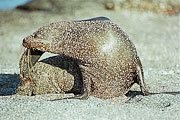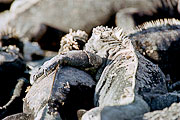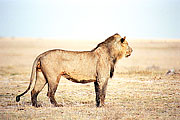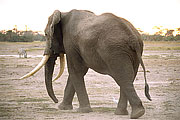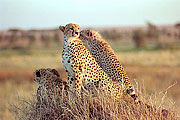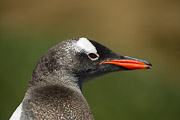 |
This article is part two of a four part series of articles describing my expedition to Antarctica. Part two describes the adventures in South Georgia. This article focuses on photography and provides tips for shooting in antarctic conditions. |
On expedition to Antarctica (18 December 2009 – January 9, 2010)
For scientific discovery, give me Scott;
For speed and efficiency of travel, give me Amundsen;
But when disaster strikes all hope is gone,
get down on your knees and pray for Shackleton
During the night the sea was quite rough, but in the course of the day it got even worse. During lunch, it became clear that more and more travelers began to suffer from the circumstances: there number of empty seats in the restaurant was increasing. Wind and waves continued to increase in force and speed. I decided to skip the lectures and stayed on bed as a precaution. During the day the storm increased to wind force 9 and waves were 6 meters high. The ship was rolling to about 38 degrees. The Russian crew said that the ship can handle a maximum of 45 degrees.
Even the bar was almost deserted. The storm continued to rise and all loose and less fixed parts of the furniture started to move and fall to the ground. Much was broken: crew and expedition members did their best but they were unable to rescue everything.
On leaving the lecture room, a passenger was thrown to the ground by a big wave. She broke a rib and was not able to attend any of the future landings during the expedition. Needless to explain her pains.
The dining room was badly affected. All starters were served, but everything fell to the ground. A big mess. In the kitchen, a refrigerator was not fixed well and fell over. The Christmas tree was no match for the conditions either.
One of the cooks came to the bar. It was a big mess in the galley. This was his third season and he had never seen worse conditions. The staff decided that Christmas dinner (it’s Christmas Eve) was postponed: eating in the dining room was too dangerous. They said that we changed course: we did not sail in the direction of South Georgia anymore, but in the direction of New Zealand. This time, that´s not the right direction …
Through the intercom we got the urgent advice to go to the cabin because that is the safest place. That´s where the food was served in a plastic cup.
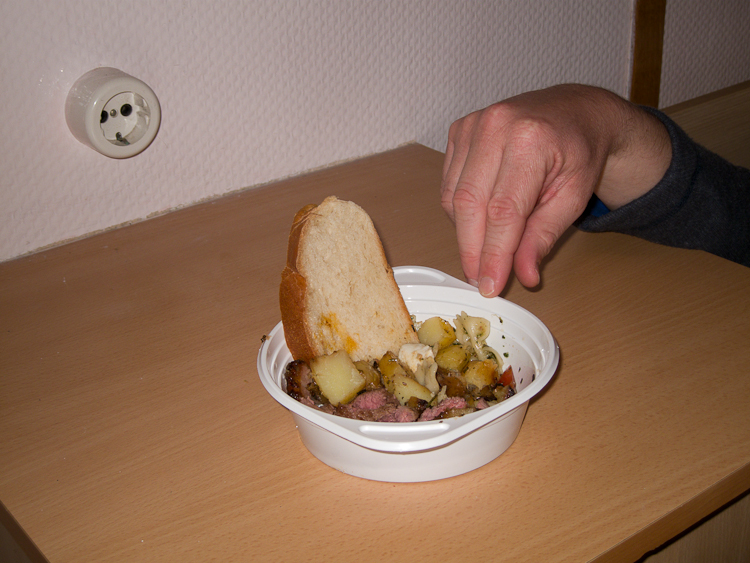
The staff are doing the best they can.
Around half past nine, the ocean calmed down a bit. We had already noticed that the ship was sailing slowly, presumably to prevent us from wandering too far from the original sailing plan. During the night the engines were fired up and we came back in a slightly heavier storm. A restless night.
Friday, December 25
We were back on course, heading for South Georgia. The ocean was much calmer, waves no more than three meters high.
The Christmas dinner was skipped for today as well, the ocean was still quite rough and they would not risk the extensive dinner they had in mind.
Saturday, December 26
In the morning we got a briefing about South Georgia, where we plan to arrive at the end of the day. We lost half a day because of the storm. We expect to arrive half past six at South Georgia. If possible, we would make a landing before we start the Christmas dinner. The cooks are not happy because that implicates that we would eat at 9 pm. First things first, we are here for the landings, not for Christmas dinner.
During the morning there were more and more animals to see in the water, dolphins, fur seals and penguins.
In the afternoon, we watched episodes 1 through 3 of the BBC documentary Life in the Freezer, on South Georgia and Antarctica. A very nice documentary with David Attenborough.
At the end of the afternoon there was land in sight. There was not much to see because there was a fairly dense fog. We were lucky and were able to land at Right Whale Bay at half past six. Huge amounts of fur seals were on the beach.
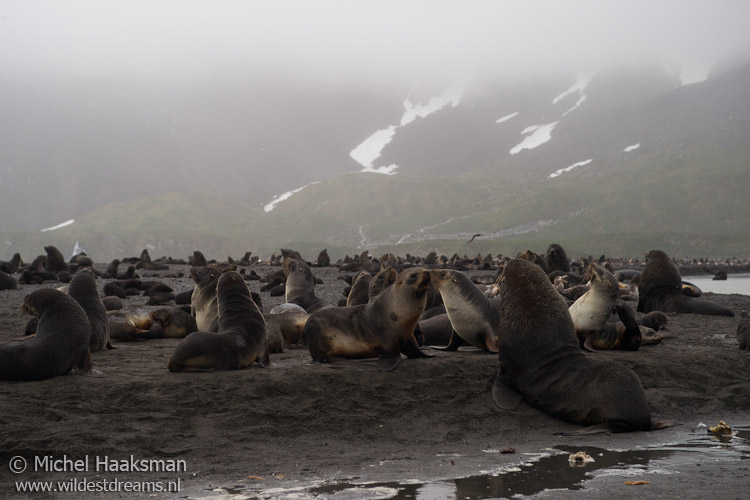
Fur seals are not very friendly…
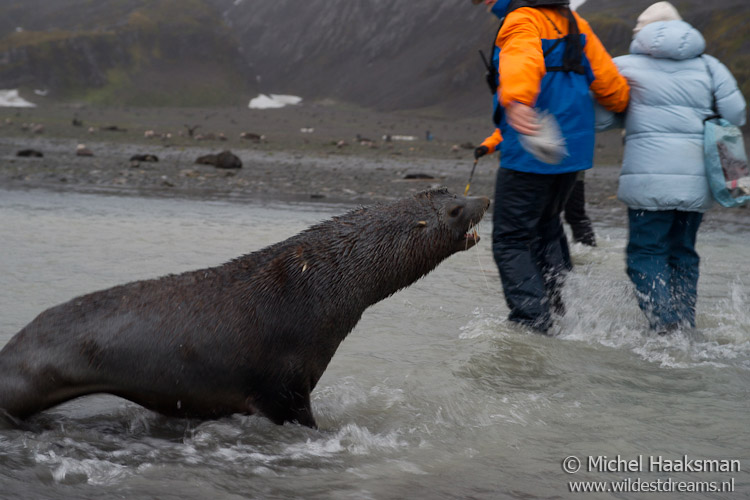
We walked to the king penguin colonies that were close by.
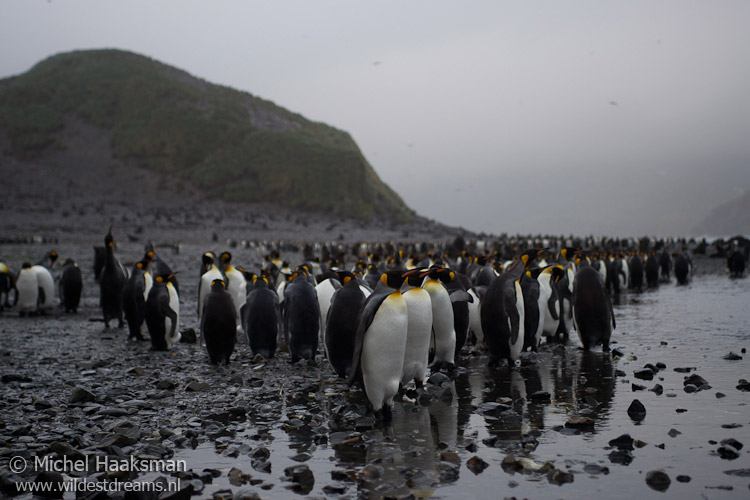
Overwhelming.
The quality of the pictures suffered from the low light conditions. For this landing I only used my Sigma 24-70 F2.8 lens. But with shutter speeds getting as low as 1/5 sec at f2.8, it is very difficult to get motion free shots, hence I ended up with lots of pictures that appeared blurry, even though shot with a tripod.
Sunday, December 27
The next morning the alarm rang at 4.55 pm. We knew that shortly after five o’clock would go ashore and we were keen to arrive early. Shortly after that Kara came over the intercom: 6 degrees Celsius, cloudy and rainy. Useful information to prepare for appropriate clothing. We were not the first in the zodiac, but were quick to land at Fortuna Bay. On the beach we immediately saw fur seals and penguins.
We left the beach and went inland, heading for a colony of king penguins. Halfway a group of deer ran past. That’s quite impressive as they come running towards you.
We arrived at a large colony of king penguins. A small hill near the colony gave a nice view of the entire group of several thousands of penguins.

In this picture, I stitched three photos taken at 24mm, to be able to capture the whole penguin colony and merge them in a panorama.
As it was raining quite hard, I was not able to make a lot of pictures. I used a plastic bag to protect the camera and lens from the rain. This is not only inconvenient, it also introduces camera shake. The wind was blowing hard and the plastic bag moved a bit in the wind, which resulted in slight camera shake even while using a tripod. Tip for next trip is to buy a better, more sturdy tripod. I also decided to buy a professional rain cap for my camera gear.
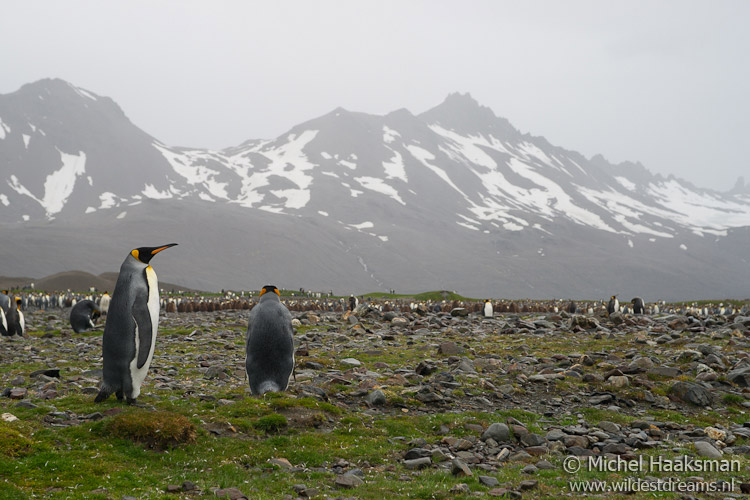
And then the moulting penguins. The poor animals are waiting in the rain for the renewal of their fur. During the moulting period, the penguin cannot swim as the fur is not waterproof. When the itching is over the penguin knows that the old fur is gone and that he can return to the water.
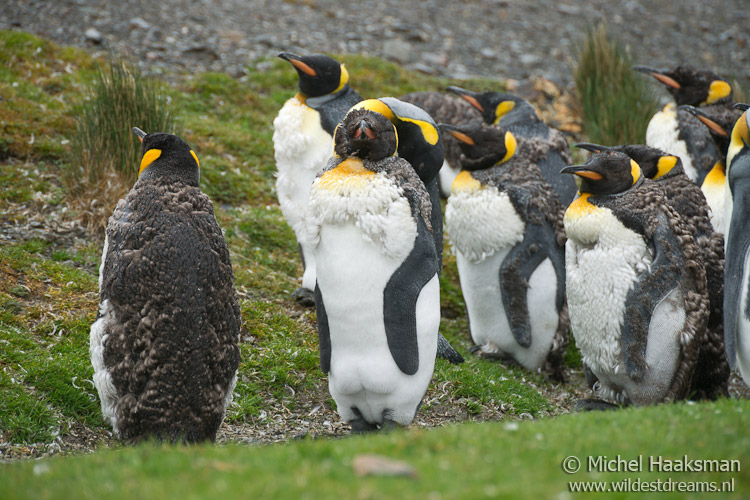
The water resistance of our stuff was challenged because it was raining pretty hard. Especially the gloves did not meet their expectations. Even though it was not freezing, the rain soaked the gloves and that resulted in cold hands. I have yet to find gloves that are waterproof and are useful to operate the camera. Until that moment, I advise to bring at least two pairs.
Time to leave…
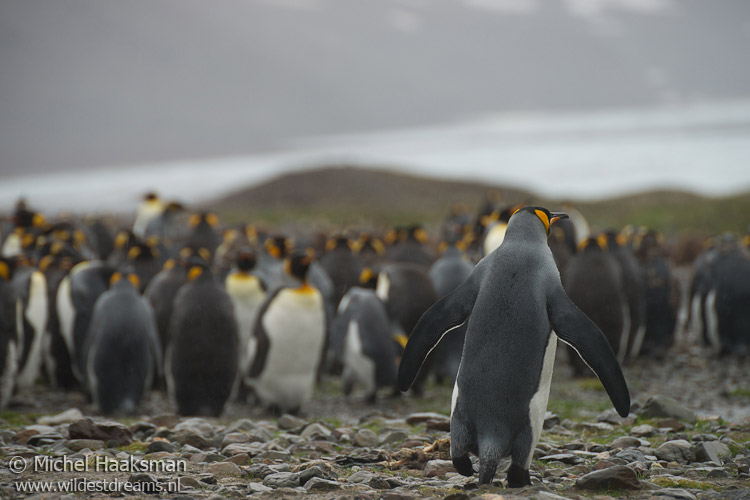
Back on the ship we put on dry clothes and had breakfast! We were ready for it. You are not allowed to bring food to the island and since the wakeup call was over 4 hours ago, we were very hungry.
Half past ten the next landing: Stromness. This is the whaling station where Shackleton arrived after his ship The Endurance was wrecked on the ice of Antarctica.
His story challenges your imagination, when you walk through the valley where he has walked and climbed over the mountains. Even now, during high summer, everything is covered with snow and ice, and leaves you speechless.
On the beach you can find huge numbers of fur seals. Especially watch out for the males, because they do not like you come too close, and get aggressive. The puppies are very cute. They look at you with their big black eyes and twist their necks in all directions.
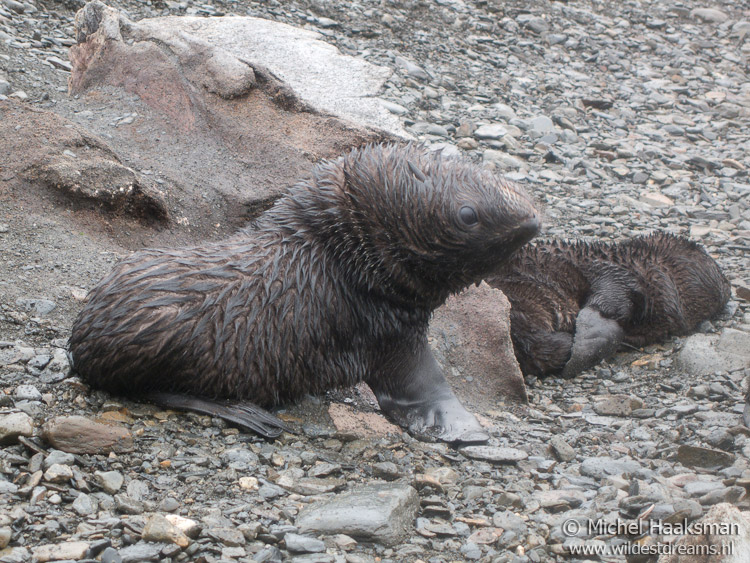
On the beach you see the whaling station Stromness. The buildings are challenged by heavy winds and material can come loose from the buildings. Metal can be tossed in the air and there is asbestos in the roofs. For this reason, the site is prohibited territory and you must stay at least 200 meters away. The fur seals don’t mind and are there in large numbers together with small groups of king penguins.
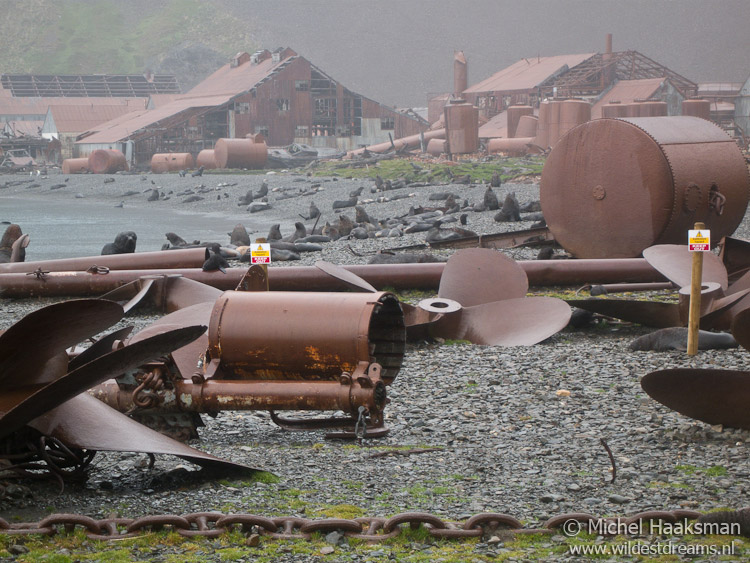
At about a mile from the beach there was a colony of gentoo penguins. Why they are at that place, is beyond me. Nearer to the coast they can also find peaks, as high as the top of the hills where they are breeding now. But it was a strange place: Gentoo penguins tend to breed on rocks, but here they make nests on bare ground. Well, we’ve already established that penguins were not prioritized when the Creator was handing out brains.
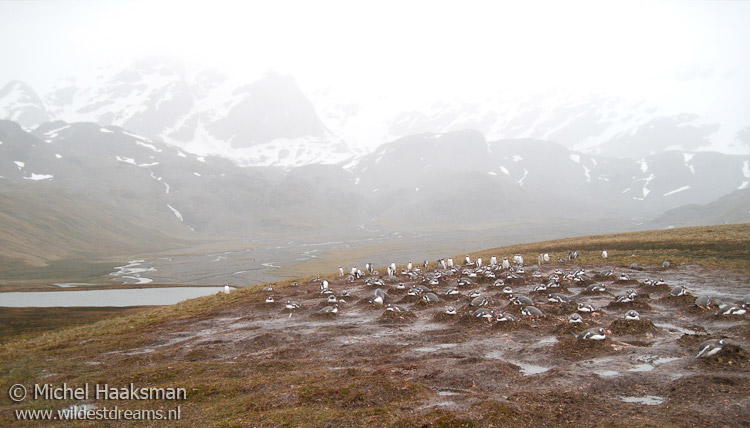
Back on board it was time for lunch. Soon after lunch, news came that the first icebergs had come in sight. They are very small at the moment, but now it is real. It was predicted that we would see icebergs here, as the Antarctic current brings water from Antarctica and therefore icebergs to South Georgia.
Learned from the weather conditions, my priority was to make my camera waterproof. A plastic bag, scissors and some tape works wonders and now the camera can be used when it rains. In South Georgia it rains 300 days per year so that is not a luxury.
During lunch the ship sailed to the next landing spot. With a short zodiac ride we reached Jason Harbour. We were already accustomed to the welcome of the fur seals. Always a beautiful sight.
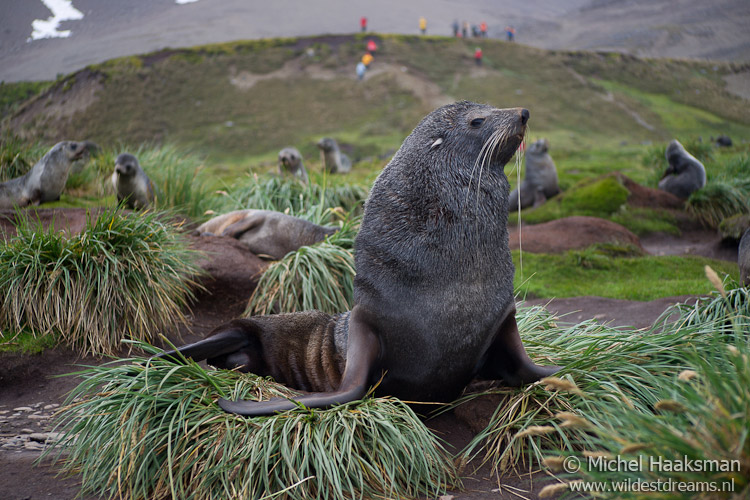
On the border of beach and grassland, we found the first elephant seals. The first ones we saw were much larger than the fur seals, but these were only the little ones.
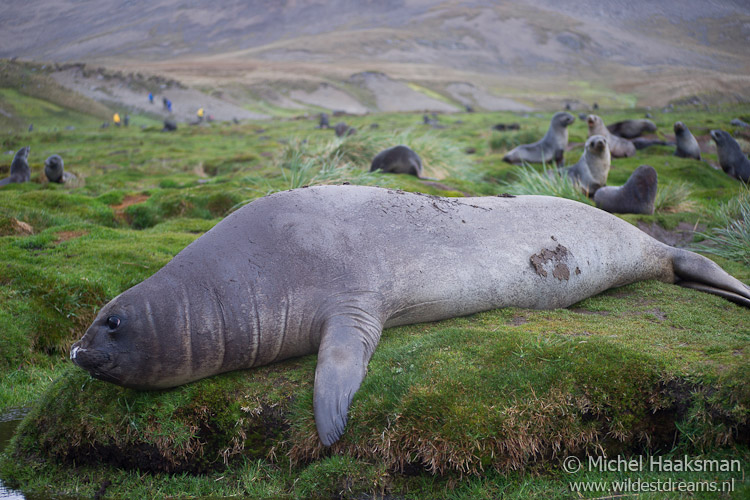
The area was a piece of grassland where many streams flow through the grassy area. Several mud pots were filled with a number of elephant seals.
They enjoy each other’s company, lying and wallowing in the mud. It smells terrible, which may have to do with the fact that they do everything in that mud. Everything.
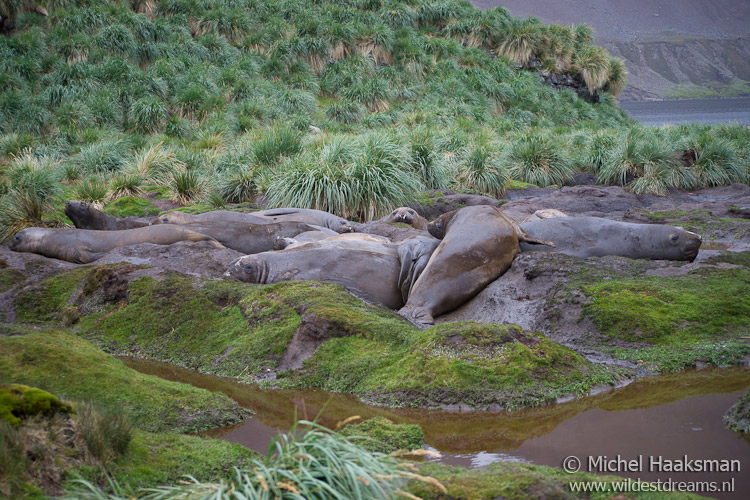
The fur seals do what do do best, like sleeping…
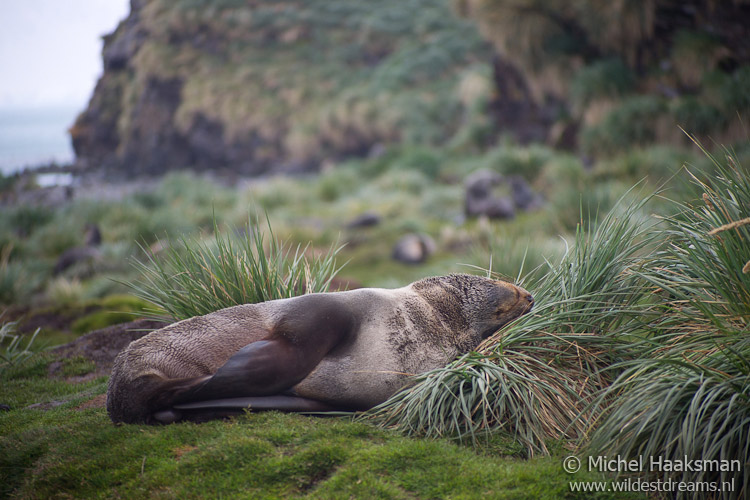
Making fun of tourists…
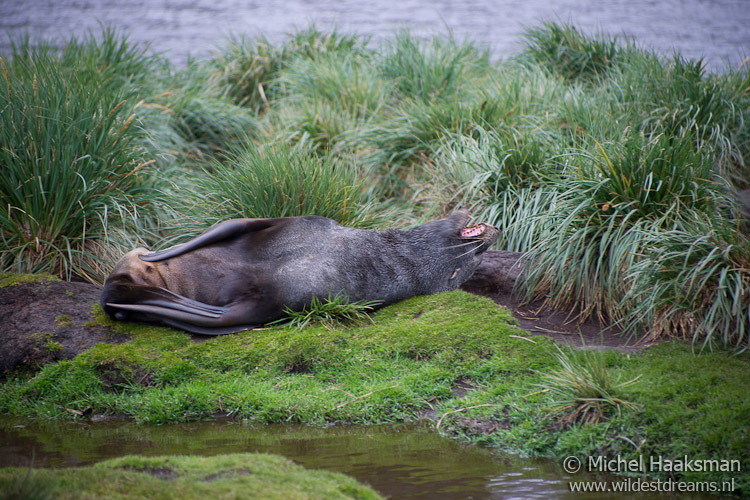
Enjoy the view…
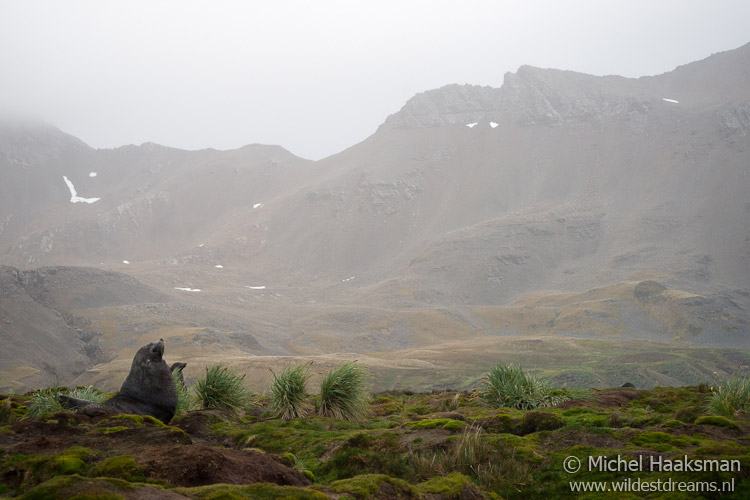
In this picture, I merged three images to a 60mpix photo. The stitching software nicely merged the in-focus parts together to create a composite that is in focus front to back.
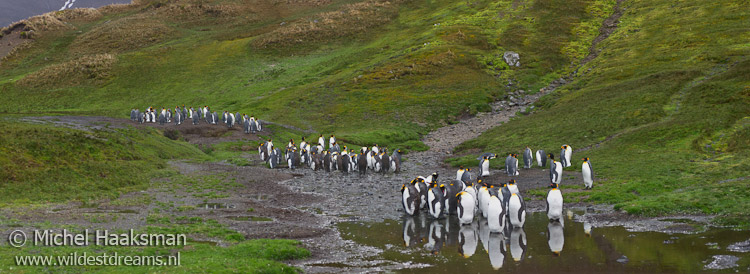
Monday, December 28
The Orlova entered the small bay of Godthul, which is surrounded by mountains and therefore provides some shelter from the wind. Somewhat later we are dropped off at the beach. Many fur seals, king penguins, gentoo penguins and elephant seals await us.
If you want to view the animals up close, just sit down, wait and see what the animals do. Often the animals will approach you, as they are very curious. Humans must allow at least 5 meters distance from the animals, but the animals do not bother with these rules. Gentoo penguins emerge from the water and walk right past you to go to their nest.
King penguins prove that they are not afraid of sea elephants: when these giants come too close, they start making a lot of noise and peck as a warning. And the sea elephants respect this. It’s very nice to watch the different species and see how they interact.
Posing for the camera

Moulting…
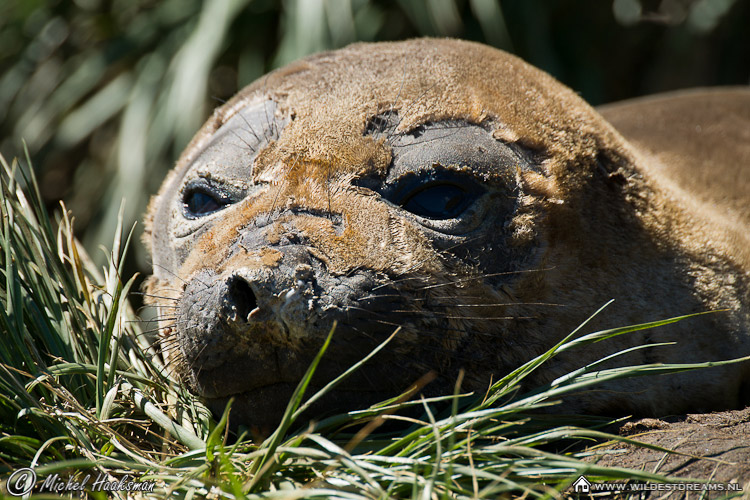
More posing for the camera

Did I already mention enjoying the sun?
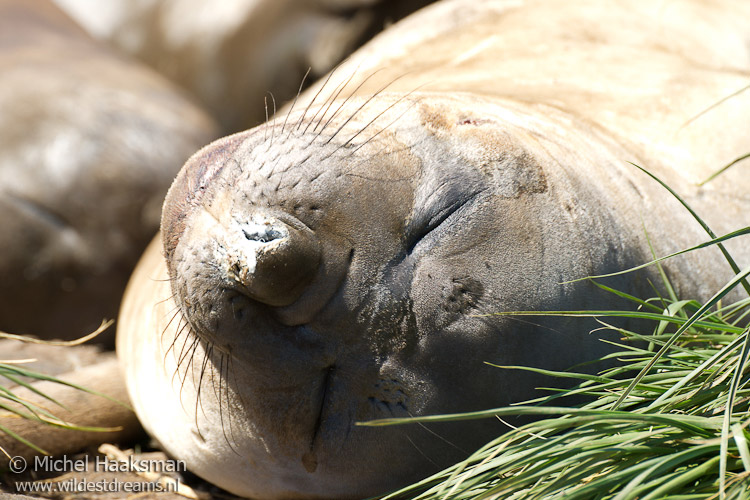
And scaring away tourists in the zodiac
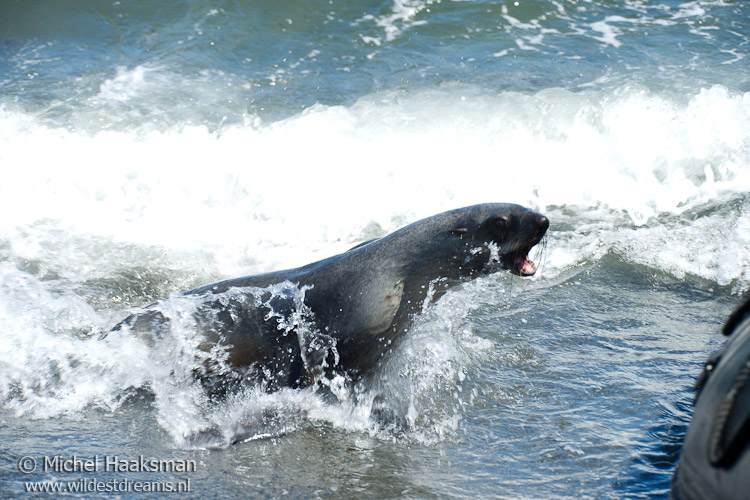
We have been told that if a fur seal is behaving aggressively, you can best try to scare him away with your voice. Failing that, try to get something between you and the animal. For example a stick. Or a whale’s bone (there are plenty on the beach). Or your tripod.
In the afternoon we arrived at Grytviken, the only inhabited place on South Georgia. We were dropped off near the small cemetery at Grytviken. Here are many whalers and fur seal hunters buried, but also Shackleton: the reason for our visit to Grytviken. At the grave, Shane held a brief eulogy and then we drank a sip of rum on Shackleton.
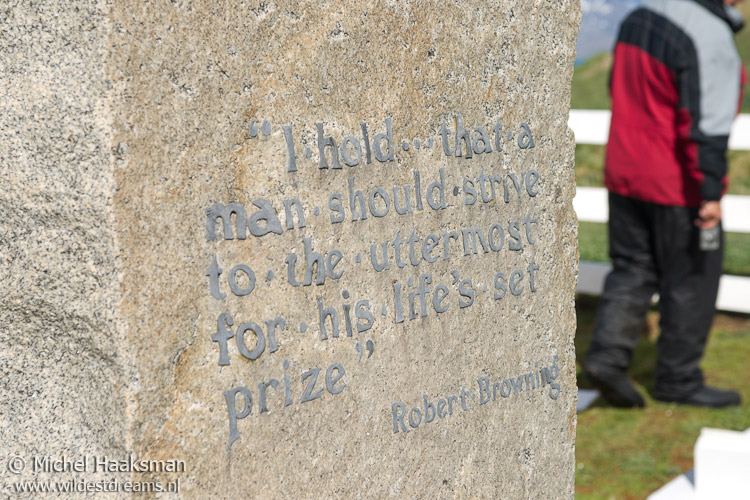
Who has a great view from his grave
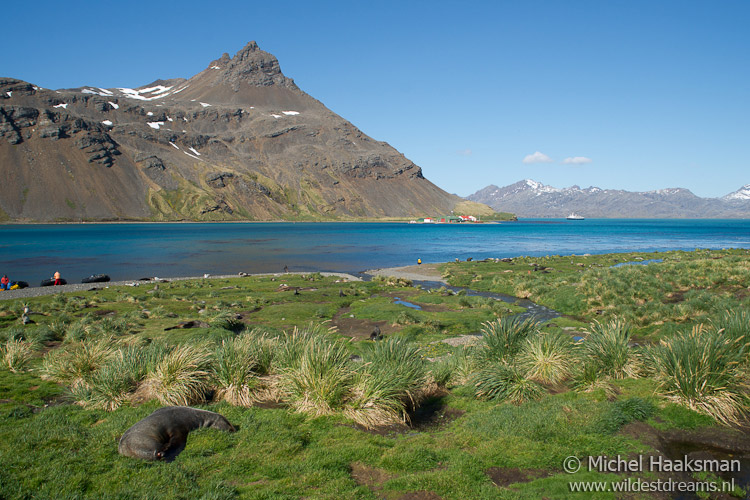
Then we examinated the old whaling station. Many of the buildings are in very poor condition, but signs tell you what they were for.
They use the same paint for everything.
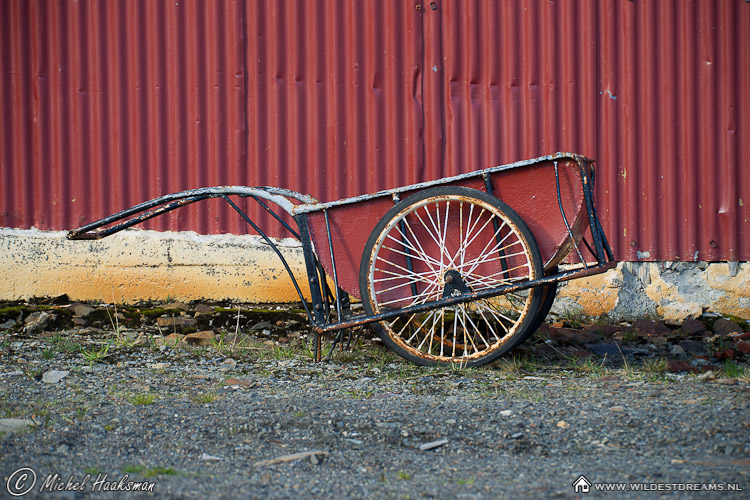
Dinner that night was a bit unusual: barbecue on deck. After dressing to the occasion, we went to the back of the ship, deck 7. There was a buffet with lots of meats, vegetables, salads, everything. There were tables and benches at the stern, so we could eat while enjoying the view of snow capped mountains around us. It was chilly, but we had a great time.
Tuesday, December 29
Breakfast at a little over six o’clock and at seven o’clock the zodiacs left for Gold Harbour. Upon arrival on the beach we were greeted by large elephant seals and a light snowfall. The elephant seals were lying on the beach, some were fighting (playfully). But even then you can already see why a fight between a beach master and his challenger does not take long. One will give up because of sheer exhaustion.
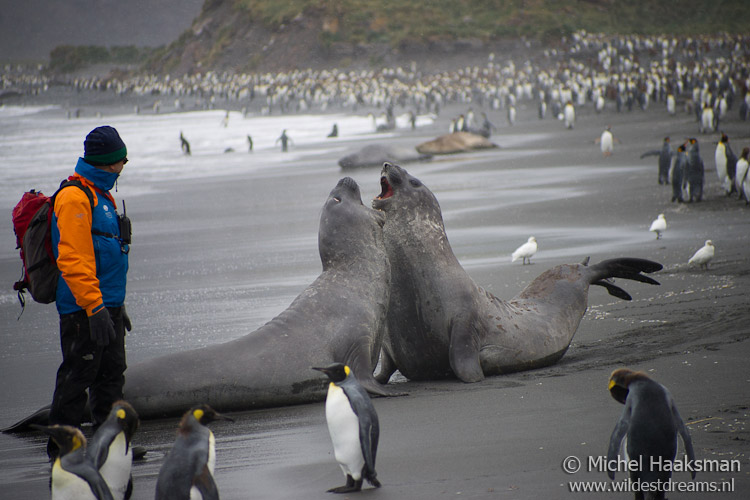
The number of king penguins is enormous. It was impossible to take the five-meter-rule into account. We have repeatedly seen that someone nearly stood on top of an animal while examining another. Two women were investigating a penguin and they did not realize that an elephant seal “ran” right behind them. Not a very elegant view.
At a certain point we were not able to walk any further: we were close to the heart of the colony. There were about 25,000 king penguins!
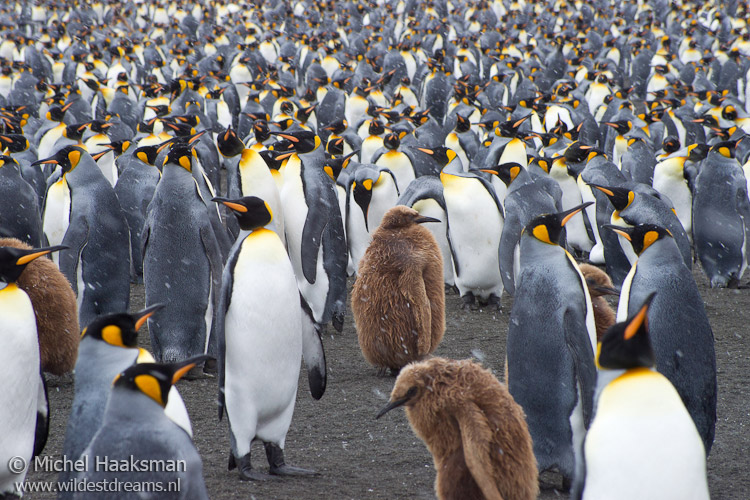
Lots of chicks, who are a lot fatter than the adults.
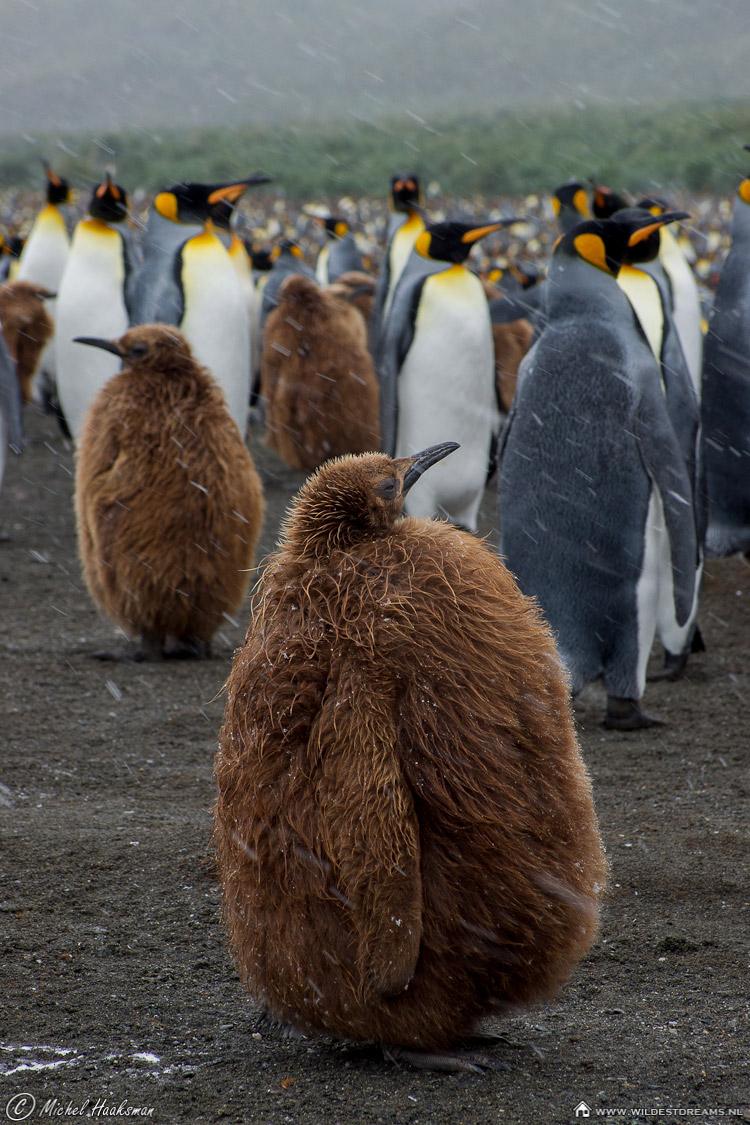
Some were trying to get rid of their last brown hairs.
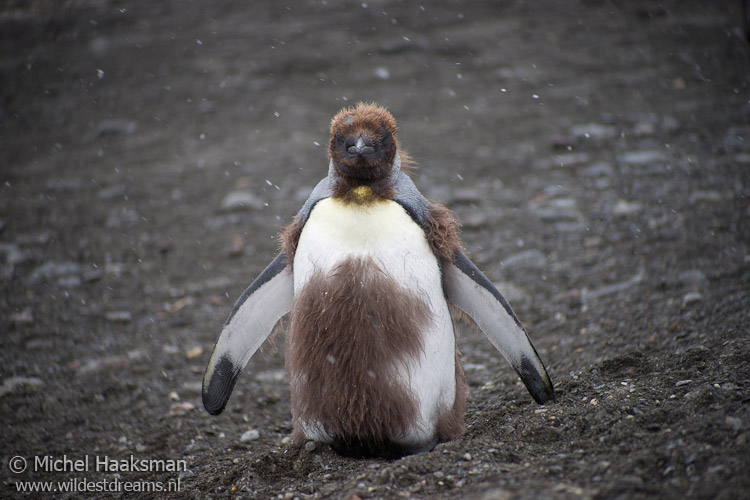
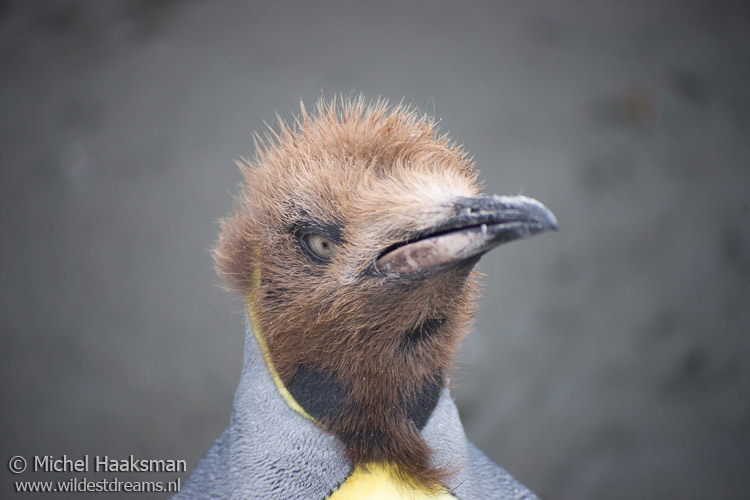
Adults are moulting, busy courting or hatching an egg.
If you stand still for a moment or just sit down, it’s likely that animals will approach you. Particularly the king penguin chicks are curious and will come to have a closer look. Or confiscate equipment.
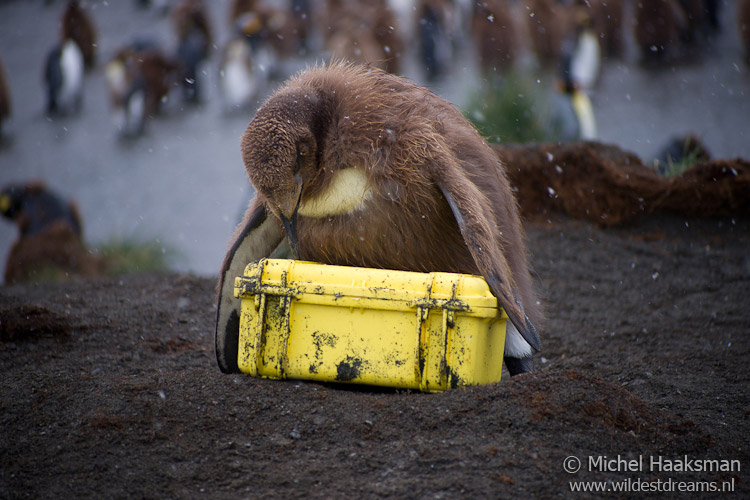
There were also lots of weeners, young elephants seals. The youngster is intensively fed and then left by its mother, who returns to sea to eat. The weener remains on the beach for six to eight weeks. In this period he continually grows. It´s mother´s milk is so rich in nutrients that it takes long to convert it into fat.
The pups seem a bit sad with their big round dog eyes, but they also seem happy with an everlasting smile on their face.
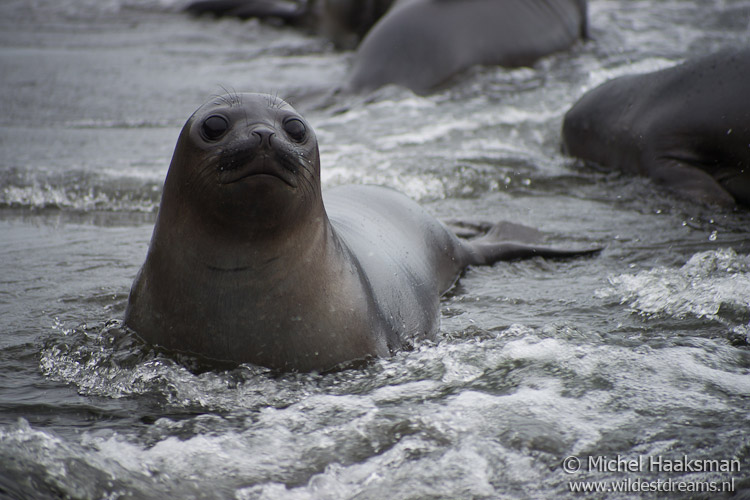
They are not aggressive at all, rather shy, but some are curious. One weener approached the tourists to see if there was any milk and began sucking pants.
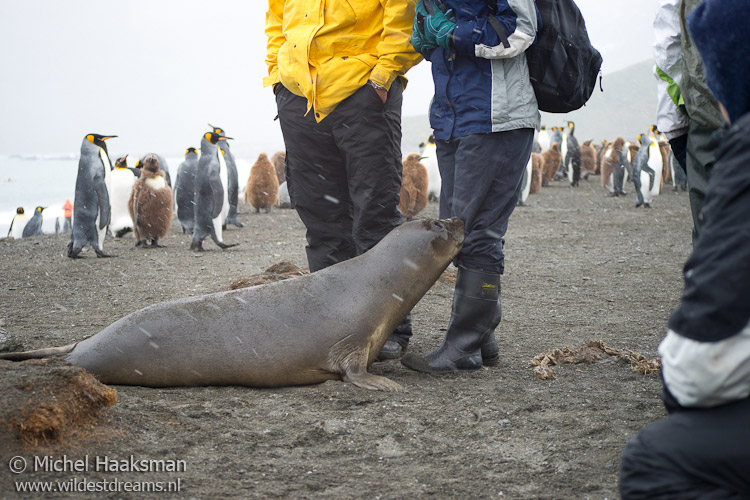
Very funny but also sad because we had nothing, of course. If such an animal is so close and literally on your feet, and stares up with his big eyes, it is very difficult to keep your hands off and not to pet him!
On Gold Harbour, I only used my 15 year old crappy Cosina 70-210 lens, as I did the waterproofing activities only for that lens. Turns out that even that lens, with proper shooting technique, provides acceptable image quality and can be sold as a stock photo.
Once all the zodiacs were back they were lifted on deck and the anchor was lifted. At 11.00 the lunch was served, and although early, it was welcomed by the guests.
We set sail to Cooper Bay. We arrived one and a half hours later and quickly went into the Zodiacs. Here we took a zodiac cruise for about an hour. Chinstrap penguins, fur seals, elephant seals, kelp gulls, white albatrosses, cormorants and macaroni penguins were seen.
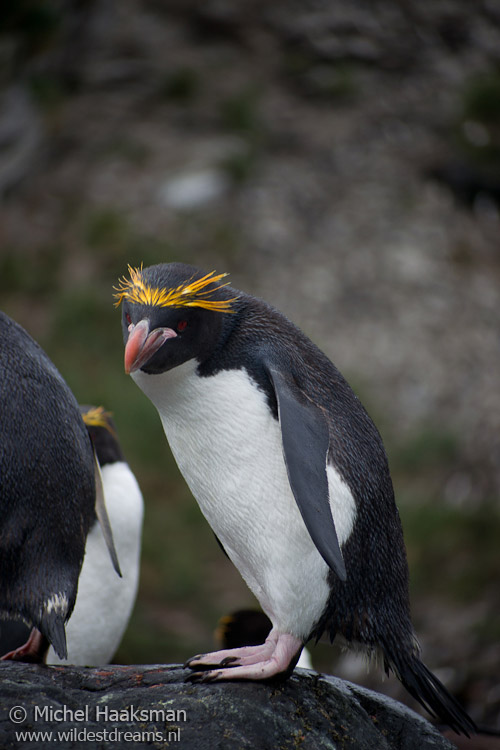
We went along the high cliffs that rise from the sea. A small bay that we entered was reminiscent of Mordor from The Lord of the Rings. It was a very nice trip.
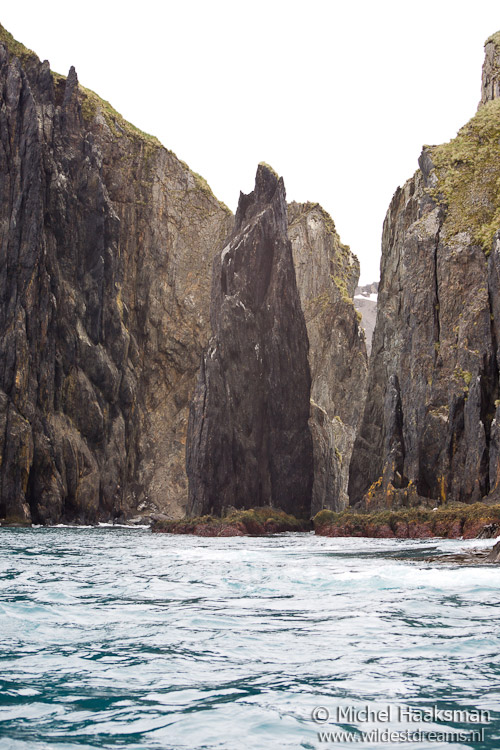
Again all pictures were taken with the Cosina 70-210. Oh boy, I really want to upgrade to a 70-200 f2.8!
Somewhat later everyone was back on the ship and we left for Drygalski Fjord. The Orlova sailed into the fjord. Dramatic views at both sides of the ship. Brilliant blue ice glaciers.

Little wildlife was to be seen in the fjord. Weather conditions were still not great and I failed to get the beautiful blue colors of the ice faithfully on a picture. Also, the pano photo above is lacking a sense of scale.
Earlier episode in the series:
• Falklands
To be continued
• South Orkney
• Antarctica
Or visit the Gallery for an overview of the best images of the trip.
